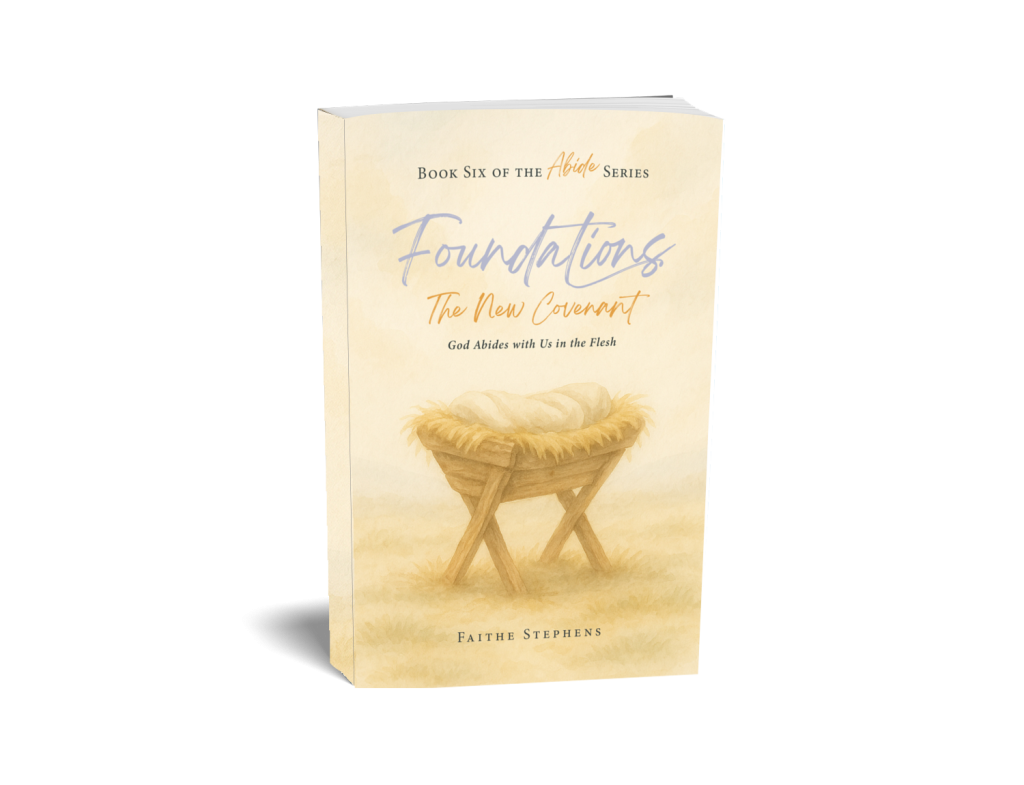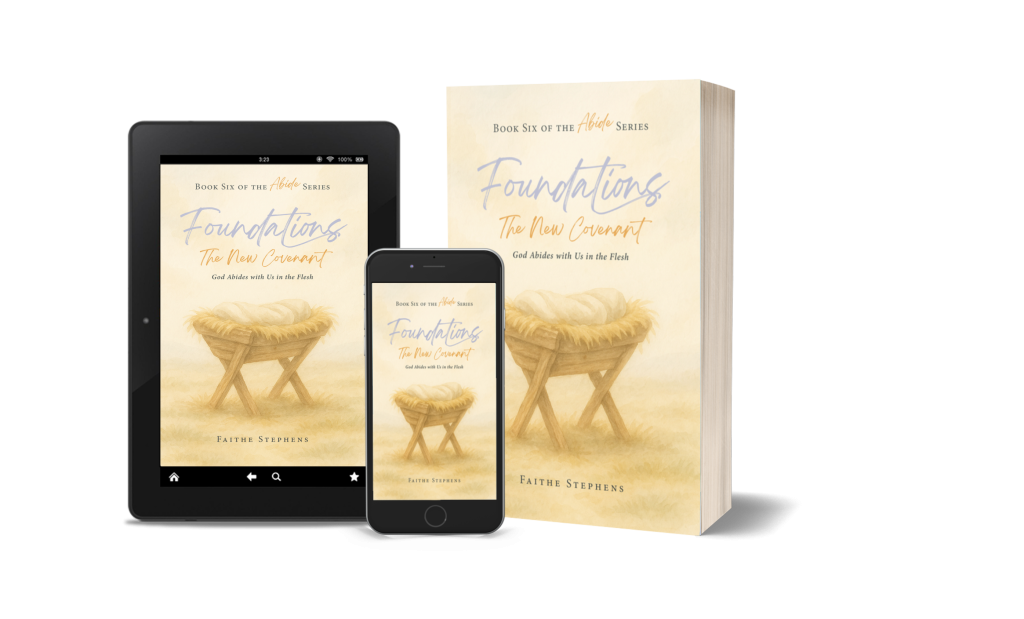Abide — The Journey
by Faithe Stephens
A sacred invitation to dwell with God,
one book at a time.

My whole life, I’ve loved the Word of God—but I know that for many, the Bible can feel overwhelming, distant, or difficult to connect with. Abide was born out of a desire to change that.
This ten-book series walks through every book of the Bible, helping readers engage with Scripture through clarity, beauty, and quiet reflection. Each book includes summaries of the text, full-color artwork, thoughtful study questions, and a look at how these ancient words still speak today.
And yes—there’s a personal reason behind the name.
When my grandparents were still dating, they used to take evening walks together. They passed a church one evening as its bells played the hymn “Abide With Me.” My grandfather turned to my grandmother and asked, “Would you abide with me?” It was his simple proposal—and the start of a lifetime of faith and love.
That word—abide—has stayed with me. It speaks of presence, devotion, and lasting connection.
That’s what this series is about. Not just reading the Bible, or studying the Bible, but learning to abide with God. I hope you will join me on this journey of learning how to Abide.

FAITHE STEPHENS
/ Author

INTRODUCING
Foundations: The New Convenant
Book$14.95
Experience the First Pages
FOR FREE
The final words of the Old Testament echo with both warning and promise. In the book of Malachi, God speaks of coming judgment, a refining fire, and a messenger who will prepare the way for the Lord. And then—the voice of prophecy falls silent.
What follows is a period of nearly 400 years, often called the Intertestamental Period or the Silent Years. Although the Bible offers no canonical record of this time, history was anything but quiet. It was a time of political upheaval, religious development, and cultural transformation—all of which would shape the world into which Jesus Christ would be born.
This chapter serves as a bridge between the Old and New Testaments, highlighting the key developments that occurred during these centuries and preparing the reader to understand the setting of the Gospels.
At the end of the Old Testament, Judah was under Persian rule, having returned from exile and rebuilt the temple. But the rise and fall of empires during this period would drastically reshape the Jewish world.
- Persian Rule (539–331 BC) – Under Persian kings like Cyrus the Great, Jews were allowed to return to their land and worship freely. The temple was rebuilt (516 BC), and religious life was restored under leaders like Ezra and Nehemiah.
- Greek Rule (331–167 BC) – Alexander the Great’s conquest spread Hellenistic (Greek) culture throughout the ancient world. After his death, his empire was divided, and Judea fell under the rule of the Seleucid Empire, leading to increasing pressure to abandon Jewish customs and embrace Greek ways.
- The Maccabean Revolt (167–160 BC) – When the Seleucid king Antiochus IV Epiphanes desecrated the temple and outlawed Jewish practices, a priestly family known as the Maccabees led a courageous revolt. Their victory restored Jewish independence for a time and led to the rededication of the temple—still commemorated today in the Jewish festival of Hanukkah.
- Roman Rule (63 BC onward) – Eventually, internal strife and external pressure brought Judea under Roman control. The Romans installed Herod the Great as king, a shrewd and brutal ruler who expanded the temple in Jerusalem but ruled with cruelty and paranoia. It was under Roman rule that Jesus would be born, and it was in this complex political landscape that the early church would take root.
During this time, Judaism evolved in several key ways:
- Synagogues emerged as centers of worship and teaching, especially for Jews living far from the temple in Jerusalem.
- The Hebrew Scriptures were translated into Greek (known as the Septuagint), making the Scriptures accessible to Jews across the Greek-speaking world.
- Several Jewish sects developed, each interpreting the law and expectations for the Messiah in different ways:
- Pharisees emphasized strict observance of the Law and traditions.
- Sadducees were temple-focused and aligned with political power.
- Essenes withdrew from society, anticipating divine judgment.
- Zealots advocated for violent resistance to Roman occupation.
Amid this diversity, the longing for a Messiah—a deliverer promised by the prophets—grew stronger. Many expected a political and military leader who would liberate Israel and restore its glory.
Though no prophetic books were written during these centuries, the voice of God was not forgotten. The people remembered the promises of Isaiah, Jeremiah, Malachi, and others. They awaited:
- A messenger who would prepare the way
- A king from David’s line
- A new covenant written on hearts
- A light for the Gentiles and glory for Israel
The stage was set, the world was watching, and the fullness of time had come (Galatians 4:4). Into this moment—after centuries of longing—would come the cry of a baby in Bethlehem, and the beginning of the greatest chapter in God’s story: the life, death, and resurrection of Jesus Christ.
Understanding this period helps us make sense of the New Testament:
- Why were the Pharisees so prominent?
- Why were the Jews expecting a conquering king?
- Why did Roman rule cause so much tension?
- Why was the temple both central and contested?
The answers lie in these silent yet formative centuries. By the time the New Testament opens, the world was hungry for hope, longing for a Savior—and the voice crying in the wilderness was about to break the silence.

Foundations: The New Covenant
The story of Scripture is not a story of rules, or rituals, or distant thrones.
It is the story of a God who moved heaven and earth to abide with His people.
Foundations: The New Covenant invites you into the sacred beginnings of that abiding story—the life, death, and resurrection of Jesus Christ.
With simple reflections, guided reading plans, and space for personal prayer and journaling, this study gently walks you through the Gospels, offering a deeper encounter with the God who pitched His tent among us.
Whether you are new to Scripture or returning with weary hope, the invitation remains the same:
Come.
Abide.
Begin again.
Reviews by Actual Readers
Get Notified About The Series!
Share The Journey
Share now



